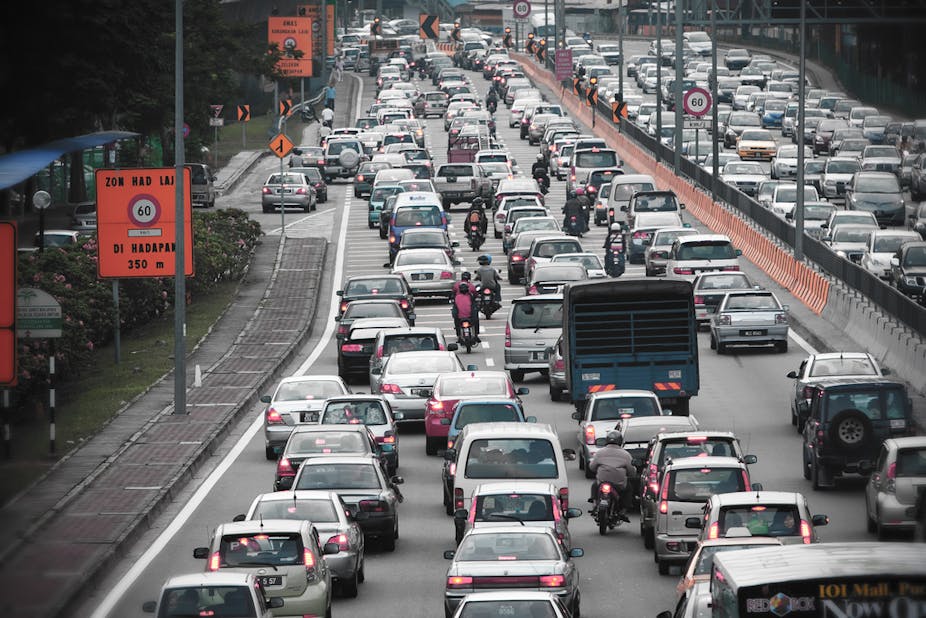“What is the value of zero?” asks the seductive commercial for the new Nissan Leaf (due to launch in Australia in April). Set against a montage of natural and man-made images of “0”, the Leaf advert asks its audience to:
“Imagine zero dependency on foreign oil, zero pollutants in our environment, zero depletion of the ozone … zero gas and 100% electric Nissan Leaf, innovation for the planet and innovation for all”.
Despite its name, is the Leaf really that great for the environment?
Electric vehicles and low-emission cars like the VW Bluemotion or the hybrid Toyota Prius are often labelled “green cars” and hailed as a technological solution to the environmental problems associated with automobiles.
Provided they run on electricity generated from renewables, electric cars do go some way toward addressing the issues of oil dependency and greenhouse gas emissions, as well as air and noise pollution from cars idling around densely populated cities. But if they run on energy generated from coal-fired power, then they merely transfer pollution from Australia’s cities to rural locations and do nothing to reduce emissions.

But even if they are run on renewables, the promise of “green cars” certainly does not address many of the more fundamental environmental, economic and social concerns associated with cars.
The green car would not reduce car use – or what Peter Newman and Jeff Kenworthy have labelled “automobile dependence”. It is likely they may even encourage more people to drive, more often. Under the misapprehension they are saving the environment, drivers will be lured into a false sense of security. “Green cars” would not reduce or address:
congestion. This puts a handbrake on the Australian economy, and chokes the movement of goods and people, effectively costing an estimated $9 billion in 2005
road deaths and injuries. More people have been killed on roads since 1945 than were killed in active service in WW2. Worldwide, 1.2 – 5 million people are killed annually. Australia recorded 1370 deaths and 32,500 serious accidents in 2010 In no other area of social life are such high rates of death and injury tolerated
health and social costs of car-dependence. These include inactivity and obesity and premature death from car-generated air pollution
social exclusion of non-drivers from spaces designed for automobiles. Many areas of society are set up for people with cars, and exclude those without one (the aged, people under 18, those on low incomes or with mobility impairment)
cars’ dominance of urban space. When stationary, automobiles consume valuable land space, both public (that could be used for growing food or green space in urban areas) and private for garages and parking lots. Inner-city public streets are clogged by parked cars. Automobiles also consume space in the form of roads and highways. Half of all US urban space is devoted to car use. In London it’s a quarter and in Sydney it’s about a third.
Private cars (whether “green” or not) also disenfranchise other forms of mobility such as cycling and walking. In many roads in Sydney it’s dangerous to ride because of road design and road rage. Pedestrians, for the most part, are treated at best as second-class citizens.

Even if engineers were able to produce a completely “green car” (one that doesn’t pollute at any stage of its life-cycle) it would be an ineffective technological fix. In most cities it’s the sheer number of cars on cities’ roads which provides the greatest challenge to making our cities livable.
Rather than a solely technological solution focused on energy and emissions, behavioural and cultural change is necessary. This would see more emphasis on decreasing automobile dependence. In other words, we should look at the way we use cars rather than just focusing on the energy they use.
One emerging phenomenon providing a radical transformation in car use in inner-city areas around the world is car sharing, known as car clubs in the UK.
Not to be confused with ride sharing or car pooling, car sharing involves a registered community hiring cars that are parked in dedicated car bays typically around the inner city, where access to alternative forms of transport are available. Unlike traditional car rental, the vehicles in car sharing are scattered in a network through local streets, within walkable distance from local residents and businesses. Car sharing is now available in more than 1000 cities across the globe.
According to Rachel Botsman and Roo Rogers, when the US government was bailing out the “big three” car companies during the global financial crisis in 2009-2010, carsharing membership increased by 52%. By 2015, an estimated 4.4 million people in North America, and 5.5 million people in Europe, will belong to carsharing services. Perhaps shared cars - not electric vehicles - are the green car of the future.

